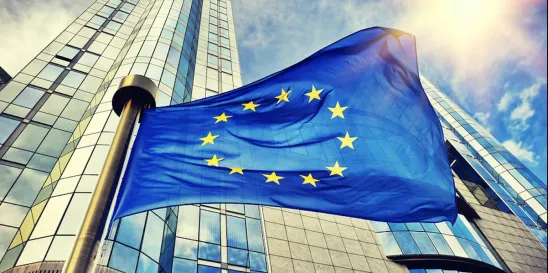The EU plans to step up controls on its home-grown technology. That is the short version.
The longer version is a (pretty dry) recitation of the proposed legislation and whitepapers that were published last week as the European Economic Security Package (ESP). We provide that (really dry . . . sorry) summary below, but hit the highlights and interesting points here, at the start. Because, in this blog (as in life) we’re here for a good time, not a long time.
The Five, Real Fast
The new ESP comprises plans for the EU to undertake the following:
1. Foreign Direct Investment Screening – Patrolling the Entire Perimeter
The ESP proposes to implement a regulation to make inbound investment screening in the EU stronger and more consistent across the Member States. We concede that this is an important and likely necessary undertaking. In fact, we wrote another [1] article on the measures here. However, it will mean that we’ll need to publish a second edition of our Foreign Direct Investment Controls – A Global Perspective. Sigh.
2. Outbound Investment Screening – Whoa, wait, WHAT?!
That is a huge step. Not every EU Member State has a viable inbound-FDI screening program, and we are now going to put together controls on outbound investment?!? That is (without wanting to editorialize in these pages), a lot.
Ok, well, in fact, it appears the EU will focus mostly on information collection in the early going—which makes sense. That is more or less how the United States is approaching its reverse CFIUS program. It is likely that both regimes begin with measuring what it is they plan to manage because it would be a bit difficult to regulate outbound investment without a reliable survey of what comprises that investment and where that investment is headed.
3. Export Control Enhancement and Coordination – Closing Up the Gaps
The main multilateral arrangement for promulgating uniform export controls across the EU is the Wassenaar Arrangement. The membership of that arrangement includes Russia.
In light of the sentences above, our keen readers will likely have deduced that there have been what the ESP delicately refers to as “blockages” in updating EU export controls through the Wassenaar Arrangement. The ESP proposes way that the EU might enhance and coordinate export controls to work around or through those “blockages” to create a uniform control across the EU.
The coordination is critical because, broadly, dual-use goods are not controlled for export between and among EU member states. Therefore, if export controls in one Member State are significantly lower than those in other Member States, a country of concern (say, Russia) could “forum shop” its way to obtaining items, through the low-control Member State, even if those items originated in a Member State that prohibits exporting the items to Russia.
4. Research and Development Support – Having it Both Ways
As it stands, EU research funding limits projects to only either their potential commercial or defense applications. Why not both, you might ask. Well, the EU is asking just that.
5. Enhancing Research Technology Controls – Deemed Exports in Europe?
This one is our dark-horse candidate for being the most interesting in the end. Language in the white paper suggests enhancements (or the consideration of enhancements) of controls that would prevent countries of concern from obtaining critical emerging dual-use technology from research centers and universities, with a particular focus on intangible technology transfers.
One of the things that has always blown our collective mind, practicing in US and EU trade regulation, is that the EU does not have a deemed export rule. Generally, if you have a foreign national in an EU country, it is not considered an export to disclose dual-use technology to that person (I know, right?!). Reading the tea leaves in this section of the ESP, it appears that position may be reconsidered.
The Longer (but still Summary) Version
Below, we provide our more complete summary of four of the five ESP initiatives touched on above.
On January 24, 2024, the European Commission published a comprehensive trade, investment, and research package as part of the European Economic Security Strategy launched in June 2023. This publication, known as the European Economic Security Package (ESP), consists of five legislative initiatives and supporting white papers addressing the following: (1) a new Regulation on the screening of foreign investments into the EU; (2) Outbound investment reviews and controls; (3) Export controls across the EU; (4) support for research and development in technologies with dual-use potential; and (5) a proposal for a Council Recommendation on enhancing research security. Through this package, the Commission aims to bolster EU economic security in the face of current geopolitical tensions and rapid technological changes, ensuring its competitiveness in core strategic industries.
This post highlights key elements from the white papers and proposals for Council Recommendation released as part of the ESP initiatives. For an overview of the proposal for a new Regulation on the screening of foreign investments, please refer to our separate blog post here.
Outbound Investments
The European Commission’s plan to develop an outbound investment review mechanism, first announced in June 2023, remains a priority. Even though, at this stage, the adoption of a new outbound investment control regime is still uncertain, the white paper on outbound investment controls outlines a collaborative approach between the EU Commission and Member States to assess the level, destination, and associated risks of outbound investments. The process involves:
- Conducting a public consultation until April 2024 to gather opinions on monitoring and subsequent risk assessments.
- Recommending EU governments to conduct a 12-month review of outbound EU investments since January 1, 2019, limited geographically and focusing on advanced semiconductors, artificial intelligence, quantum technologies, and biotechnologies.
- Sharing data and information through an expert group to produce a joint EU security risk assessment report.
- Determining policy responses jointly between the European Commission and Member States, with a further communication expected in Autumn 2025.
The U.S. is also in the process of implementing its own outbound investment regime, as detailed in our previous blog post on the August 2023 Executive Order issued by the Biden Administration.
Coordination of Export Controls
The EU export-control regime (in place since 2009) largely implements multilateral export-control arrangements (including the Wassenaar Arrangement on export controls for conventional arms and dual-use goods and technologies).
The regime underwent a major upgrade in 2021, enhancing coordination between the Member States. However, EU governments still have sole authority to control the export of items not subject to multilateral arrangements. This has led in recent years to divergence in the scope of controls across the bloc
The first white paper scrutinizes the existing disparities in export controls among Member States. It proposes measures to foster uniform and effective controls across the EU, aiming to initiate discussions with Member States, the European Parliament, and stakeholders. The proposals include:
- Introducing new items on the EU control list that had been supported by EU Member States but were not adopted by the multilateral export control regimes after being blocked by certain members, in particular Russia.
- Establishing a high-level forum for discussing export control developments and promoting a unified EU position.
- Enhancing coordination of Member States’ National Control Lists through a voluntary approach ahead of their adoption.
- Bringing forward the evaluation of the current Dual-Use Regulation to the first quarter of 2025 from 2026–2028. That evaluation may result in more radical changes being proposed and subsequently adopted, including the adoption of an European equivalent to the U.S. deemed export rule.
Research & Development Involving Technology with Dual-Use Potential
Many technologies that are critical to the EU’s economic security and strategic autonomy have a dual-use potential. These technologies are relevant for many fields in both civil and defense domains and could benefit European industry and the wider economy.
The white paper on enhancing support for research and development in technologies with dual-use potential evaluates current EU funding programs in light of geopolitical challenges and assesses whether this support is adequate for technologies with dual-use potential. It outlines three options for the future:
- Building on the current setup, focusing exclusively on civil or defense applications. This option would build on the current approach characterized by an exclusive focus on either civil (through Horizon Europe) or defense applications (through the European Defence Programme). Incremental improvements would be introduced that can already be tested in the current EU funding programs.
- Removing the exclusive focus on civil applications in selected parts of the successor program to Horizon Europe. This option would allow strategic emerging technologies to be supported independently of the field of application (defense or civil) in selected parts of the program – subject to specific conditions. At the same time, all other parts of the program would maintain an exclusive focus on civil applications.
- Creating a dedicated instrument for R&D with dual-use potential, alongside maintaining mutually exclusive civil and defense research programs. This option involves creating an instrument exclusively devoted to research with dual-use potential, while the research and development programs for civil and defense purposes would continue to maintain their mutually exclusive focus.
Industry stakeholders are invited to provide comments on these options through a consultation open until April 30, 2024.
Proposal for a Council Recommendation on Enhancing Research Security
Research security refers to risks related to the international nature of scientific research. These risks include the following: (i) sharing sensitive knowledge and technology can jeopardize European and national security if channeled into military purposes by a foreign research partner; (ii) EU academic education and research can be improperly influenced by or from other states; and (iii) technologies are used to suppress or undermine fundamental values, both in the EU and elsewhere. The level of awareness of these risks and related countermeasures and policies is not even across the EU, creating vulnerabilities that could be exploited and could hinder the functioning of the European Research Area.
In order to address risks related to the international nature of scientific research, the EU Commission proposes a Council Recommendation on research security. The proposal includes:
- Core principles for implementing research protection measures internationally.
- Guidance for public authorities to support research funding organizations.
- Recommended actions for research organizations.
- EU contributions to research security, including the establishment of a European center of expertise.
FOOTNOTES
[1] Eye-piercing syntactical abomination included for emphasis.
Listen to this article here.




 />i
/>i

